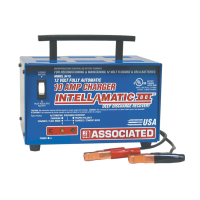
Do you have a question about the Associated Equipment 9410 and is the answer not in the manual?
| Brand | Associated Equipment |
|---|---|
| Model | 9410 |
| Category | Battery Charger |
| Language | English |
Instruction to retain the manual for future reference.
Warning to charge only lead-acid batteries to prevent injury and damage.
Avoid exposing the charger to moisture or weather conditions.
Use only manufacturer-recommended attachments to prevent hazards.
Proper method for disconnecting the charger's plug to prevent cord damage.
Ensure the power cord is positioned safely to avoid damage or tripping.
Guidelines for using extension cords, including type and condition.
Do not use a charger with a damaged cord or plug; seek repair.
Do not use a damaged charger; have it serviced by a qualified professional.
Avoid disassembling the charger; service by qualified personnel only.
Unplug the charger before maintenance or cleaning for shock prevention.
Warning about explosive gases from lead-acid batteries; read manual carefully.
General safety measures to take when working near batteries.
Ensure someone is nearby and keep first aid supplies accessible.
Wear protective eyewear and clothing; avoid touching eyes.
Procedures for handling battery acid contact with skin or eyes.
Avoid sparks or flames near batteries due to explosion risk.
Prevent dropping metal tools on batteries to avoid sparks and explosions.
Remove metal jewelry to prevent short circuits and burns from battery sparks.
Charger is for lead-acid batteries only, not other types.
Never attempt to charge a battery that is frozen.
Steps and precautions before starting the charging process.
Steps for removing battery from vehicle for charging.
Ensure good ventilation around the battery during charging.
Clean battery terminals to ensure good connection and prevent corrosion.
Add distilled water to battery cells to specified levels, but do not overfill.
Follow specific battery manufacturer instructions for charging.
Verify battery voltage and set charger accordingly; start with lowest charge rate.
Position charger away from the battery to prevent damage from gases.
Avoid placing the charger directly over the battery to prevent corrosion.
Prevent battery acid from contacting the charger.
Operate the charger in a well-ventilated area, not enclosed spaces.
Do not place batteries on top of the charger.
Connect/disconnect clamps only after charger is off and unplugged.
Ensure secure clamp connection to battery terminals for good contact.
Route cords to avoid damage from moving engine parts or doors.
Maintain clearance from moving engine parts during connection.
Identify positive and negative battery posts, noting diameter differences.
Determine which battery post is grounded to the vehicle chassis.
Connect RED clamp to POSITIVE post; BLACK clamp to chassis or engine block.
Connect BLACK clamp to NEGATIVE post; RED clamp to chassis or engine block.
Turn off, disconnect AC, remove clamp from chassis, then battery.
Check battery post polarity, noting diameter differences.
Attach a 24-inch, 6-gauge cable to the NEGATIVE battery post.
Connect the POSITIVE (RED) charger clamp to the POSITIVE battery post.
Connect the NEGATIVE (BLACK) charger clamp to the free end of the attached cable.
Do not face the battery when making the final connection.
Disconnect in reverse sequence, breaking the first connection at a distance.
Marine batteries must be removed and charged on shore.
Charger is equipped with grounding plug for shock risk reduction.
Plug must connect to a properly installed and grounded outlet.
Adapter can be used if outlet is not properly grounded, but ensure ground connection.
Adapter use is not allowed in Canada; use proper outlet.
Approximate recharge time depends on battery AH depleted and charger rate.
Explanation of indicator lights: Red, Green, Yellow, Blinking Yellow, Blinking Green.
Indicates deep discharge recovery process for flooded batteries.
Charger tests polarity for 5 seconds before applying current to avoid sparking.
During the 5-second delay, the charger tests for a deep discharged battery.
Charger selects rate, adjusts current for battery state to avoid heating.
A cycle to reach 100% charge; blink yellow indicates vehicle start readiness.
Charger maintains voltage, recharging if it drops below 12.5 VDC.
Program designed to recover deeply discharged batteries, not for sealed types.
Restrictions for charging VRLA batteries; never use 'FLOODED' setting.
Step-by-step guide for connecting and charging a battery.
Notes on handling unchargeable batteries, fully charged batteries, and load testing.
List of replacement parts with item numbers and part numbers.
Schematic diagram illustrating the charger's internal wiring.
Guidance on replacing worn parts and general maintenance safety.
